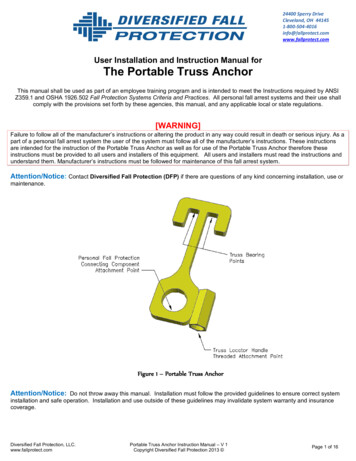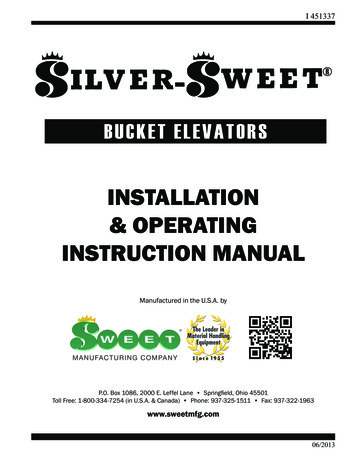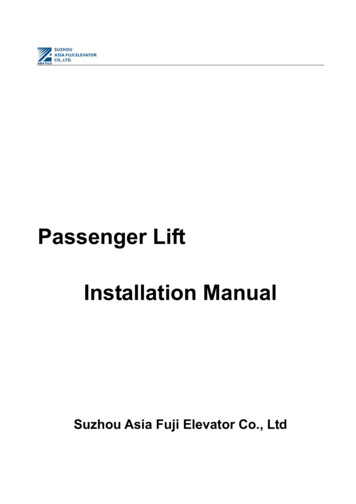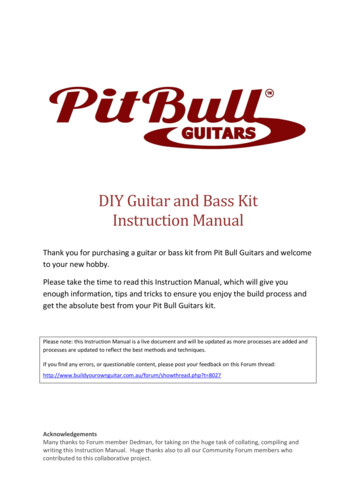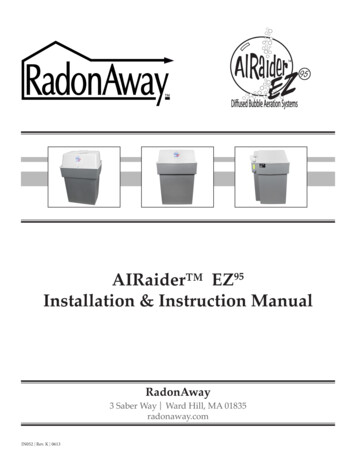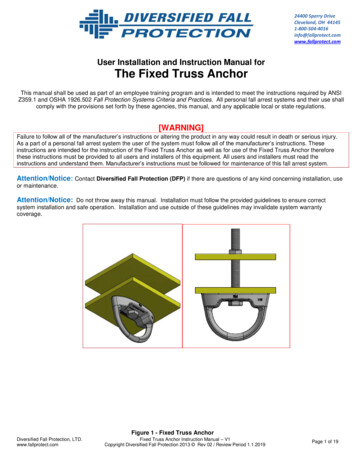
Transcription
24400 Sperry DriveCleveland, OH tect.comUser Installation and Instruction Manual forThe Fixed Truss AnchorThis manual shall be used as part of an employee training program and is intended to meet the instructions required by ANSIZ359.1 and OSHA 1926.502 Fall Protection Systems Criteria and Practices. All personal fall arrest systems and their use shallcomply with the provisions set forth by these agencies, this manual, and any applicable local or state regulations.[WARNING]Failure to follow all of the manufacturer’s instructions or altering the product in any way could result in death or serious injury.As a part of a personal fall arrest system the user of the system must follow all of the manufacturer’s instructions. Theseinstructions are intended for the instruction of the Fixed Truss Anchor as well as for use of the Fixed Truss Anchor thereforethese instructions must be provided to all users and installers of this equipment. All users and installers must read theinstructions and understand them. Manufacturer’s instructions must be followed for maintenance of this fall arrest system.Attention/Notice: Contact Diversified Fall Protection (DFP) if there are questions of any kind concerning installation, useor maintenance.Attention/Notice: Do not throw away this manual. Installation must follow the provided guidelines to ensure correctsystem installation and safe operation. Installation and use outside of these guidelines may invalidate system warrantycoverage.Figure 1 - Fixed Truss AnchorDiversified Fall Protection, LTD.www.fallprotect.comFixed Truss Anchor Instruction Manual – V1Copyright Diversified Fall Protection 2013 Rev 02 / Review Period 1.1.2019Page 1 of 19
Diversified Fall Protection, LTD.www.fallprotect.comFixed Truss Anchor Instruction Manual – V1Copyright Diversified Fall Protection 2013 Rev 02 / Review Period 1.1.2019Page 2 of 19
I. Applications:A.Purpose:The purpose of the fixed truss anchor, FTA, also known as the fixed anchor assembly, FAA, (see figure 1) is to beused as an anchor point of a personal fall arrest system. It is designed to be used with a full body harness withback dorsal D-Ring, a carabiner, and a self-retracting lifeline (SRL).B.Limitations: Capacity – The fixed truss anchor is not to be used by persons with a total weight over 310 pounds. Thistotal weight includes body weight, and the weight of any clothing, tools, and equipment. Fall Clearance – In general industry, when working on a surface 4 feet or higher from ground level, perOSHA, fall protection is required. This system is designed to prevent serious injury or death in the event ofa fall. There must be sufficient clearance below the user to arrest a fall before theuser strikes the ground or other obstruction. Clearance required may increasedepending on but not limited to some of the following factors: worker height,worker weight, and movement of attachment element, elevation of anchorageconnector, SRL length, other obstructions, deceleration distance and free falldistance.Figure 2 - Fall ClearancesC. WARNING: Working surface must be at least 6’6” from the groundsurface when user is in upright standing position to prevent seriousinjury and/or death (See Figure 2). Swing Falls – A swing fall occurs when the anchor point is not directly abovewhere a fall occurs. Minimize this hazard by working with the anchor overheadas much as possible. The suggested safe work area is within a 30º downwardfacing cone from an overhead anchor point to harness D-Ring (See Figure 3).The extra force of striking an object in a swing fall may cause serious injuryFigure 3 - Safe Work Areaor death and should therefore be avoided whenever possible. The requiredclearance significantly increases when a variable length subsystem such as a self-retracting lifeline is used. Environmental Hazards – Extra precautions may be required to safely use this system if other hazards inthe surrounding environment exist. Such hazards include, but are not limited to: extreme temperatures,power lines, moving machinery, sharp edges, corrosion, and toxic fumes. Please contact DFP if you haveconcern of any such conditions existing where this equipment is being used. Training – This equipment is only permitted to be installed and used by certified fall protection competentpersons that have been trained in the correct use and application of the portable truss anchor.Standards: Please refer to all families of standards regarding occupational safety for more information on workpositioning systems and fall protection. These include ANSI, OSHA, and any applicable local or staterequirements.II. System Requirements:A.Compatibility: Compatibility shall follow all requirements of OSHA 1926.502 (d) as well as these instructions and those ofthe SRL, harness, and other components.Diversified Fall Protection, LTD.www.fallprotect.comFixed Truss Anchor Instruction Manual – V1Copyright Diversified Fall Protection 2013 Rev 02 / Review Period 1.1.2019Page 3 of 19
B. The design of the fixed truss anchor is made for use only with approved components and subsystems. Nonapproved components and subsystems may jeopardize the compatibility of equipment and affect the safetyand reliability of the complete system. A connector is considered compatible with the fixed truss anchor when they have been designed to worktogether in a manner that the gate mechanism cannot accidentally be opened no matter how they becomeoriented. Connectors must be compatible with the attachment point and must be capable of supporting a minimum of5000 pounds. Do not use a non-compatible connector as it may unintentionally disengage. Connectorsmust be compatible in strength, size, and shape. Self-locking snap hooks and carabiners are required byANSI and OSHA.Connections: Only use of snaphooks and carabiners meeting ANSI Z359.1-2007 3.2.1.4 are permitted for use with thisequipment. This requires that “snaphooks and carabiners shall be self-closing and self-locking and shall becapable of being opened only by at least two consecutive deliberate actions”. Furthermore, “the gate of asnaphook or carabiner shall be capable of withstanding a minimum load of 3,600 pounds without the gateseparating from the nose of the snaphook or carabiner body by more than .125 inches”. All connectors mustbe compatible in size, strength, and shape. Ensure all connectors are fully closed and locked. Snap hooks and carabiners shall never be connected:oooooooC.D.To an attachment point where another connecter is already attached.In a way that would result in a load on a gate.In false engagement where features that protrude from the connector catch on the anchor andseems to be fully engaged without visual confirmation.To each other.Directly to webbing, rope lanyard, or tie-back.To any object which will not allow the connector to close and lock.To any undersized or irregular shaped element, as it may apply a force to the snap hook gatecausing unintentional disengagement, also known as a roll-out.Personal Fall Arrest System: A full body harness must be worn when this equipment is used as a component of the fall arrest system. OSHA requires that a fall arrest system must be capable of arresting the user’s fall with a max arrestingforce (MAF) of 1800 pounds. DFP designed this system with a max limit of 900 pounds. OSHA requires that the free fall limit is 6 feet or less. This system has been designed for use with a web or cable style self-retracting lifeline. Lanyards are notpermitted to be used with this system.Anchorage Strength: The required strength is dependent on the type of application that is being used. ANSI Z359.1 requiressystems to have a strength capable of sustaining static loads as follows:oo Fall Arrest:(a) 5000 pounds for non-certified anchorages(b) Two times the MAF for certified anchorages.Rescue:(a) 3000 pounds for non-certified anchorages(b) Five times the foreseeable force for certified anchoragesThese strengths also apply to the anchorage location when attached to a truss.Diversified Fall Protection, LTD.www.fallprotect.comFixed Truss Anchor Instruction Manual – V1Copyright Diversified Fall Protection 2013 Rev 02 / Review Period 1.1.2019Page 4 of 19
III.A. If multiple systems are being attached to the same anchorage point in any of the prior applications, thestrengths defined shall be multiplied by the number of systems attached to the anchorage. WARNING: The anchorage connector shall be marked or labeled with its intended application. Useof equipment for an application that does not meet the strength requirements can result in seriousinjury or death.Installation and Use: WARNING: Prior to install, all instructions must be read and understood for each component of thispersonal fall arrest system. WARNING: Do not alter or misuse this equipment. Consult DFP before using the fixed truss anchorwith any other component or subsystem than designed for. Other components may interfere withthe proper operation of this equipment. Use extra caution around electricity, moving machinery,chemical hazards, and sharp edges. WARNING: Pregnant women and minors must not use the fixed truss anchor system. Age andfitness also affect the ability to withstand falls. Consult your doctor if you have any doubtsregarding your ability to safely absorb a shock from a fall arrest. WARNING: Proper Personal Protective Equipment must be worn throughout the entire installationprocess. OSHA 1910.135(a) (1) states “each affected employee wears a protective helmet whenworking in areas where there is a potential for injury to the head from falling objects.” Protectiveeyewear is also required as part of this system. WARNING: Avoid power lines and any other potential overhead hazards when installing the fixedtruss anchor. Maintain a minimum 10 foot distance from any electrical hazard.Planning RequirementsPlan your system prior to installation. Consider any factor that may affect a user’s safety. Key points to consider are:anchorage, sharp edges, post-fall lock out, and rescue.B.Installation RequirementsAnchor Locations - Truss anchorage locations must be approved by a safety engineer or a qualified person and mustmeet all of the requirements of these instructions (See Figure 4).1.2.3.4.May not be at the end of a truss.May not be between the first and second panel point.Must be located between two panel points.Should be as close to a panel point as possible.Figure 4- Anchor LocationsDiversified Fall Protection, LTD.www.fallprotect.comFixed Truss Anchor Instruction Manual – V1Copyright Diversified Fall Protection 2013 Rev 02 / Review Period 1.1.2019Page 5 of 19
Truss Requirements1. Bottom Chord (See Figure 5):ooooDepth, D, of bottom chord vertical leg of angles must be between 1-1/4 inch and 3 inches.The thickness, Y, of the bottom chord must be a minimum of 1/4 inch.The gap, S, must be a minimum of 3/4 inch.Must be hot rolled steel with minimum tensile yield strength of 36 kips per square inch.Figure 5 - Bottom Chord Detail2. Truss SpanooooooC.Bracing shall be straight, undamaged, and meet the original design intent.The span and loading of the truss affects the allowable concentrated load that may be applied to thetruss. It must be capable of withstanding a concentrated load of 900 pounds with a safety factor of two(2) for certified anchorages and 5000 pounds for non-certified anchorages.No more than one user is permitted at a time per truss.Do not attach to a truss that is smaller than 18 inches in height.An acceptable truss must be designed according to the Steel Joist Institute (SJI) and be a K, KCS, LH,or DLH series truss.The truss must be inspected by an engineer or qualified person for structural integrity whichincludes but is not limited to corrosion, end connections, size, load capacity, welds, existingloading, bracing, span, or any other unsafe conditions.Installation & User InstructionsCAUTION: Installation & user instructions are to be fully read and understood before proceeding with installationand/or use of the FTA fall arrest system.Installation Directions:1. Tie off may be required during installation of the Fixed Truss Anchor: If installing from a ladder, refer to your company’s safety policy regarding tie off requirements. If installing from a lift, refer to your company’s safety policy regarding tie off requirements.Diversified Fall Protection, LTD.www.fallprotect.comFixed Truss Anchor Instruction Manual – V1Copyright Diversified Fall Protection 2013 Rev 02 / Review Period 1.1.2019Page 6 of 19
2. Visually determine a location on truss for proper installation of fixed truss anchor. Refer to Figure 4 – AnchorLocations for proper anchor locations on truss.3. Remove lock nut, split lock washer, and 5” x 5” plate from the fixed truss anchor assembly.4. With bolt through D-Ring and 5” x 5” plate, insert bolt through space between bottom chord angles of truss(See Figure 6).Figure 6 - D-Ring and Bottom PlateAligned on Truss5. Place 5” x 5” plate, then split lock washer, and finally lock nut onto bolt (See Figure 7, 8, 9).Figure 7 - Top Plate on AssemblyFigure 8 - Split Washer on AssemblyFigure 9 - Lock Nut on AssemblyDiversified Fall Protection, LTD.www.fallprotect.comFixed Truss Anchor Instruction Manual – V1Copyright Diversified Fall Protection 2013 Rev 02 / Review Period 1.1.2019Page 7 of 19
6. CAUTION: The bolt head must be below the truss and the excess thread with washer and nut on top of thetruss. Failure to do so will cause interference with the connection that could result in injury or death.7.Plates and D-Ring must all run parallel to the truss (See Figure 10)Figure 10 - Proper Assembly of FTA8. Check visually to make sure anchor is properly aligned with the truss (See Figures 11 - 17). PROPER ANCHOR INSTALLATIONYES!!Figure 11 - Good AnchorPlacementFigure 12 - Good AnchorAlignmentDiversified Fall Protection, LTD.www.fallprotect.comFixed Truss Anchor Instruction Manual – V1Copyright Diversified Fall Protection 2013 Rev 02 / Review Period 1.1.2019Page 8 of 19
INPROPER ANCHOR PLACEMENTFigure 13 - Anchor too close toedgeNO!!Figure 14 - Plates and D-RingNOT parallel to trussFigure 15 - Plates are reversedFigure 16 - Not Enough TorqueFigure 17 - Bolt is upside downDiversified Fall Protection, LTD.www.fallprotect.comFixed Truss Anchor Instruction Manual – V1Copyright Diversified Fall Protection 2013 Rev 02 / Review Period 1.1.2019Page 9 of 19
9. Tighten the system to 75 foot-pounds torque. Make sure to torque the nut, not the bolt (See Figure 18). Recordtorque on inspection and maintenance log. Note: Understand proper use of torque wrench before performing this step. Do not over tighten nut.Figure 18 - Torque Lock Nut to 75 ft-lb10. Attach carabiner of SRL to D-Ring of Fixed Truss Anchor. Also refer to SRL user manual.Figure 19 - SRL Attached to FTAvia CarabinerDiversified Fall Protection, LTD.www.fallprotect.comFixed Truss Anchor Instruction Manual – V1Copyright Diversified Fall Protection 2013 Rev 02 / Review Period 1.1.2019Page 10 of 19
11. Attach 4” Steel Ring to snaphook of SRL if using retrieval pole option. Otherwise, attach a tagline to be able toproperly retrieve the SRL for use. (See Figure 20). Note: This can also be done when parts are unpacked.Figure 20 - Attach Steel Ring to SRL Snaphook12. Visually inspect connection to make sure the SRL is properly attached to the anchor.13. Test attachment by pulling SRL away from anchor to ensure they are connected.14. It is now safe to begin using the Fixed Truss Anchor as a single point attachment of a fall arrest system.User Instructions:Retrieval Pole Option:1. Attach Portable Truss Anchor to extension pole by rotating anchor clockwise (See Figure 21).Figure 21 - Attach PTA to Extension Pole2. Visually inspect connection to ensure anchor is secured to the pole.3. Adjust pole to the proper length and lock in place (See Figures 22-23).Diversified Fall Protection, LTD.www.fallprotect.comFixed Truss Anchor Instruction Manual – V1Copyright Diversified Fall Protection 2013 Rev 02 / Review Period 1.1.2019Page 11 of 19
Figure 22 & 23- Adjust and Unlock4. Lift and extend pole to raise anchor up towards SRL on the Fixed Truss Anchor.5. Use the truss bearing points of the PTA to hook the 4” Steel Ring attached to the SRL (See Figure 24).Figure 24 - Use PTA to Grab Ring & SRL6. Pull pole and attachments down and take hold of the ring/snaphook (See Figure 25).7. Set PTA assembly asideFigure 25 - Pull down SRLSnaphook8. Remove steel ring from snaphook and set aside.9. Attach snaphook to back D-Ring of full body harness following the manufacturer’s instructions (See Figure 26).Diversified Fall Protection, LTD.www.fallprotect.comFixed Truss Anchor Instruction Manual – V1Copyright Diversified Fall Protection 2013 Rev 02 / Review Period 1.1.2019Page 12 of 19
Figure 26 - Connect Snaphook to Harness10. The FTA fall arrest system is now ready to use. It is safe to ascend to higher elevations.11. To disconnect, descend to ground level. Then repeat steps 1-9 in reverse.CAUTION: Thoroughly inspect equipment for damage before each use.CAUTION: The anchor must be above the user’s head. Keeping the anchor directly above the user will help prevent swingfalls. This will minimize injury and prevent death in the event of a fall.IV.Training:A.It is the responsibility of the end user to be familiar with these instructions regarding use of the fixed truss anchorsystem. The end user is also responsible for the correct care, use, characteristics, limitations, and consequences ofmisuse of this equipment.B.Training is to be conducted prior to initial installation of the system. It should also be repeated on a regular basis.Training must be performed without the user being exposed to an actual fall hazard. The end user is to keeptraining documentation on file.V.Inspection:A.The fixed truss anchor is to be inspected for damage (bends, cracks, excessive wear, signs of permanentdeformation) before each use.B.C.D.A formal inspection of the entire system shall be conducted at least annually. This inspection shall be performedby a competent or qualified person that is not the end user. The results are to be recorded in the inspection andmaintenance log.Inspection Procedure: Inspect fixed truss anchor for any damage or corrosion. Pay close attention for any signs of permanentdeformation such as cracks or wear that could jeopardize the integrity of the strength of the system. Inspect the truss attachment points. The anchor must be securely positioned on the truss. Inspect all system components. Make copies of the inspection log included at the end of this manual. Use it to record inspection results ofall components used with the anchor.If inspection reveals any damage or unsafe conditions, immediately remove anchor from service and contactDiversified Fall Protection for further instructions.Diversified Fall Protection, LTD.www.fallprotect.comFixed Truss Anchor Instruction Manual – V1Copyright Diversified Fall Protection 2013 Rev 02 / Review Period 1.1.2019Page 13 of 19
VI.VII.Maintenance Clean the fixed truss anchor with a mild solution of soap and water. This will prevent excessive build-up ofdirt and other debris that could prevent proper operation. Store non-fixed equipment in a secured clean, dry, and non-corrosive environment. Keep equipment records which contain data pertaining to any maintenance or incidents.Specifications and PartsA. System as an assembly is rated for a 310 pound user. Contact DFP if a greater capacity is required.B. Fixed Truss AnchorAnchorage Connector PenSafe 3732-11-C-11-3 Assembly Drop forged steel 1/2 inch clearance hole 5000 pound tensile strength 100% proof loaded to 3600 pounds For use with bolts and lock washer of a minimum grade 5 quality. 75 foot-pound required torque value Weight: 1 poundFigure 28 & 29 – D-Ring Anchorage ConnectorHardware 1/2”-13 x 5 inch Hex Tap Bolt Full Threado 1/2 inch diametero Finish: Zinco Material: Steelo Grade 5o Coarse thread, size 13, right-handedo Weight: .2624 pounds 1/2” Medium Split Lock Washero Nominal size: 1/2 incho Nominal thickness: .125 incho Inner/Outer diameter: .512 inch/.869 incho Finish: Zinco Material: Steelo Weight: .335 pounds 1/2”-13 NE Lock Nuto ½ inch diametero Finish: Zinco Material: Steelo Style: Nylon inserto Grade 5o Coarse thread, size 13o Thickness: .609 incho Weight: 1.1175 poundsFigure 30 - Hex Tap BoltFigure 31 - Split LockWasherFigure 32 – Lock NutSteel plates Material: A36 SteelDiversified Fall Protection, LTD.www.fallprotect.comFixed Truss Anchor Instruction Manual – V1Copyright Diversified Fall Protection 2013 Rev 02 / Review Period 1.1.2019Page 14 of 19
Finish: Powder Coat Safety Yellow Top plateo 5 inch wideo 5 inch longo 3/8 inch thick Bottom Plateo 5 inch wideo 5 inch long3/8 inch thickMaximum Allowable loading One (1) 310 Pound User Mass Arresting Force of 900 poundsC. Self-Retracting Lifeline (Figure 33) 20ft Rebel AD120A with AJ520A hook on lifeline, AJ514A carabineer on housing Webbing: 20 feet of 1” wide polyester webbing (shock absorber is nylon) Housing: Anodized aluminum Stainless Steel: Drum spring, pawls, pawl springs and external fasteners Alloy Steel/Plated: Shaft, ratchet plate, and end plates Snap Hook: AJ520A, zinc plated alloy steel 5000 lb. min. tensile strength. Capacity: 310 pounds when used independently of the system. Weight: 5.1 lbs. with AJ520A hook & Carabineer Size: 5.5” diameter x 2” thick Max. Arresting Force: 900 lbs.D. Full Body Harness (See Figures 34)Repel Technology Webbing: Material PolyesterFigure 33 - Rebel SRL Width 1.75 in (4.45cm) T. Strength Stan 6,000lbs (2,722 kg) Belt 11,000lbs (4,990 kg) T&B 8,800lbs (3,992 kg) Treatment: NanosphereComfort Padding Hip padding Materials (where applicable) Nylon & Polyester Dri-Lex Aerospace Mesh EVA Foam 420D PVC fabricTech Lite Quick Connect Buckle Materials 7075 & 6061 Aluminum Alloy Stainless Steel per ASTM A240 Alloy Steel SAE AMS 6350 (zinc plated finish)Figure 35 - D-Ring & No-Tangle T. Strength 4,000lbs (1,815kg)PadRevolver Vertical Torso Adjustor (See Figure 30) Materials Alloy Steel AISI 4140 (zinc plated finish)Figures 34 – Delta III Harness Stainless Steel Nylon 6-6 T. Strength 4,000lbs (1,815kg)D-rings (See Figure 35) Material Heat treated Alloy Steel with zinc plate finish T-Strength 5,000 lbs (2,268 kg)No-Tangle D-ring Pad (See Figure 35)Diversified Fall Protection, LTD.www.fallprotect.comFixed Truss Anchor Instruction Manual – V1Copyright Diversified Fall Protection 2013 Rev 02 / Review Period 1.1.2019Page 15 of 19
Material UrethaneLabels Material VinylThread Material High Strength PolyesterRated for 310 Pound Capacity when used with this system.VIII.LabelingThe following label must be present and fully legibleFigure 36 – Required Tag(Front & Back) WARNING: If label is missing from anchor, remove from service and contact DFP immediately.Diversified Fall Protection, LTD.www.fallprotect.comFixed Truss Anchor Instruction Manual – V1Copyright Diversified Fall Protection 2013 Rev 02 / Review Period 1.1.2019Page 16 of 19
IX.Inspection and Maintenance LogInspection DateInspection Items NotedCorrective ActionMaintenance PerformedApproved by:Approved by:Approved by:Approved by:Approved by:Approved by:Approved by:Approved by:Approved by:Approved by:Approved by:Approved by:Approved by:Approved by:Approved by:Approved by:Approved by:Approved by:Approved by:Approved by:Approved by:Diversified Fall Protection, LTD.www.fallprotect.comFixed Truss Anchor Instruction Manual – V1Copyright Diversified Fall Protection 2013 Rev 02 / Review Period 1.1.2019Page 17 of 19
Inspection DateInspection Items NotedCorrective ActionMaintenance PerformedApproved by:Approved by:Approved by:Approved by:Approved by:Approved by:Approved by:Approved by:Approved by:Approved by:Approved by:Approved by:Approved by:Approved by:Approved by:Approved by:Approved by:Approved by:Approved by:Approved by:Approved by:Diversified Fall Protection, LTD.www.fallprotect.comFixed Truss Anchor Instruction Manual – V1Copyright Diversified Fall Protection 2013 Rev 02 / Review Period 1.1.2019Page 18 of 19
Diversified Fall Protection, LTD.www.fallprotect.comFixed Truss Anchor Instruction Manual – V1Copyright Diversified Fall Protection 2013 Rev 02 / Review Period 1.1.2019Page 19 of 19
User Installation and Instruction Manual for . The Fixed Truss Anchor . This manual shall be used as part of an employee training program and is intended to meet the instructions required by ANSI Z359.1 and OSHA 1926.502 . Fall Protection Systems Criteria and Practices. All personal

